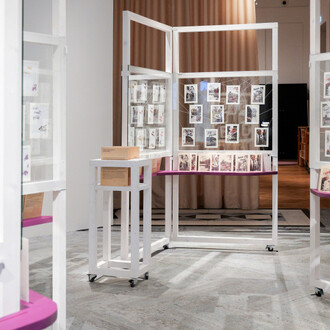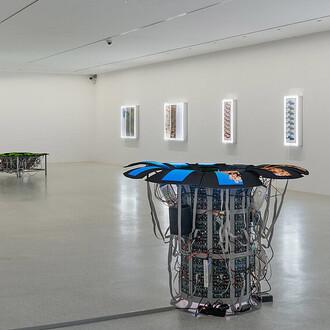A water-drinking shepherd boy. Here, the human completely merges with the earth. It could be a sheep or a cow heading to the water in the scorching sunlight.
(Albin Egger-Lienz, "The source")
The element of water possesses remarkable versatility in art. From realistic depictions to abstract metaphors, it serves as a medium for artists to explore aesthetic, emotional, social, and philosophical concepts. The phrase Don’t go near the water, a song title by the American rock band The Beach Boys, encapsulates the multifaceted connotations of water: it can be a warning about ecological dangers, a symbol of the unknown, a barrier, nostalgia, or the constant flow of life. This ambivalence is vividly reflected in the works of the featured artists Erwin Gross, Tobias Hantmann, Elke Silvia Krystufek, and Josef Zekoff.
Erwin Gross is a painter of abstract atmospheres, where water appears as a often unidentifiable motif. His paintings are characterized by atmospheric density and transparency, reminiscent of fog or mist. His process-oriented application of color—layering, washing out, and piling up pigments—evokes the fluidity and behavior of water on a surface. Gross creates suggested, dissolved landscapes where forms blur, and the boundary between object and abstraction becomes fluid. Here, water symbolizes ambiguity, hidden beauty, and the melancholic mood created by translucent color applications.
In Tobias Hantmann’s work, the dialectic of form and dissolution is revealed. Fountain motifs recur in his paintings over the years. Whether central and filling the image or emerging at different points, they traverse the surface, appearing and disappearing, challenging the distinction between figure and ground. For him, these motifs become a meditation on perception, illustrating the impossibility of fixation through the form of the rising and falling water jet, which peaks and then descends again. Hantmann’s fountains evoke associations with branching plants, blood vessels, ejaculation, or exclamation marks. They disturb, they seem tragic, playful, festive, and everyday. As an unfathomable motif, they invite viewers to surrender to the beauty of transience.
Elke Silvia Krystufek uses water as a central metaphor for identity, desire, and transformation. It represents a space of retreat and longing, beyond societal norms and urban order. In her exhibition Liquid logic (MAK, Museum of Applied Arts, 2007), she links water to the concept of a fluid, non-binary self—thinking of identity as something mobile and open. From a feminist perspective, she employs the motif to question rigid gender roles and to portray the body as a permeable, changeable system. The water motif also references artistic positions like Bas Jan Ader, whose disappearance at sea she interprets as a symbol of slipping out of fixed roles. Water thus becomes an aesthetic and political medium for self-empowerment, dissolution, and redefinition.
Josef Zekoff also rarely depicts water explicitly, but its qualities resonate in his mysterious and fragmentary visual language. A central theme in his work is vessels, often empty or only suggested. These vessels, traditionally holding water, symbolize potentiality and the capacity to contain or preserve. Zekoff’s flowing, labyrinthine forms and lines can evoke underground rivers or invisible currents, creating a dreamlike and disorienting atmosphere. The bathers, who "look out from the frame," serve as a key to what lies outside. They act as a bridge between the depicted world and the viewer’s reality, breaking the boundary of the image and drawing attention beyond the painted surface. What lies outside is thus the viewer’s space, the real environment, as well as the imagination and memories evoked by the artwork.
The phrase Don’t go near the water may be a warning, but the artistic positions in this exhibition prove that it is worth repeatedly approaching the water, in all its forms and meanings.










